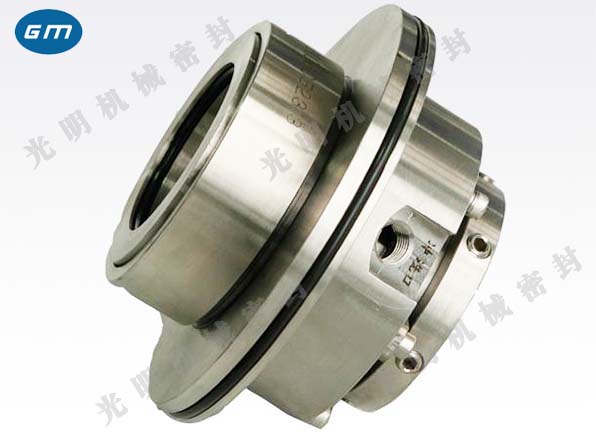Mechanical seal manufacturer Overview of the principle of mechanical seal
The mechanical seal depends on a pair of Cartridge mechanical seal Or several pairs of end faces that are perpendicular to the shaft for relative sliding under the action of fluid pressure and the elastic force (or magnetic force) of the compensation mechanism, and are equipped with auxiliary seals to prevent leakage.
Common mechanical seal structure consists of stationary ring (stationary ring), rotating ring (moving ring), spring seat of elastic element, set screw, auxiliary seal ring of rotating ring and auxiliary seal ring of stationary ring. Anti rotation pin is fixed on gland to prevent rotation of stationary ring.
Rotating ring and stationary ring can also be called compensation ring or non compensation ring according to whether they have axial compensation capability.

Shaft seal box
In the past, the shaft seal box containing mechanical seal was a stuffing box designed for soft packing seal. It is not suitable for holding mechanical seals. Not only is the size too small, the gap too narrow, but also the simple cylinder shape is not suitable.
The standard of oversized mechanical seal shaft seal box has been formulated abroad. In addition, the United States_ Both Durametalek and the British Hydrodynamics Research Group are studying a reasonable mechanical seal shaft seal box. Its shape should not only be conducive to fluid flow and heat dissipation, but also be conducive to the removal of solid particles, creating a good surrounding environment for the seal.
Volatile matter emission control
In the past, only attention was paid to the elimination of visible fluid leakage, without paying attention to the control of invisible volatile matter emission, which would cause environmental pollution and be dangerous to devices and people. Foreign countries, such as the Sealing Technical Committee of the American Friction Society and the Society of Lubricating Engineers, have formulated guidelines for the regulations on the control of volatile emissions of rotating machinery, compressors and screw systems with mechanical seals, SP-30 (1994), SP-32 (1990) and SP-33 (1991). SP-30 is implemented in three stages. The definitions of blocking fluid and buffer fluid are clearly defined, and the wrong and confused concepts are clarified. Blocking fluid refers to the fluid introduced between double seals to completely block the process fluid leakage to the surrounding environment. The pressure of the blocking fluid is always higher than the pressure of the process fluid being sealed. Buffer fluid is the fluid used as lubricant or buffer between two seals, and the pressure of buffer fluid is always lower than the pressure of sealed process fluid.
Matching of auxiliary system
In the auxiliary system of mechanical seal, cooling, heating, flushing and other systems need to be matched, the pump circulation needs to be optimized, and the condition monitoring system and other problems are being studied and solved. Auxiliary system matching is specified in API-682 standard.
Gas blockage sealing system
In the past, liquid blocking liquid or liquid blocking gas was commonly used in the blocking seal system. In order to simplify the huge blocking liquid system, blocking gas was used to block liquid or gas blocking seal system can use spiral groove gas seal and blocking gas, floating sleeve and blocking gas to block gas and liquid.











